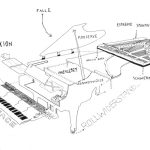Project 88

PROJECT 88
The analogue instrument piano and its eighty-eight keys or pitches form the framework of the joint programme.
The instrument is measured, recorded and deconstructed acoustically and optically: all the strings of the piano are excited, recorded, digitally stored and later transformed in various ways. Parallel to this acoustic process, the piano’s sound-box (wooden body, steel frame, strings, keyboard, etc.) is measured by means of hand drawings and micro-camera recording and transferred onto the level of the image.
In this way the piano becomes a sound and image generator, on the one hand an electronic sound reservoir in the form of samples and a potential optical projection reservoir in the form of drawings and recordings, on the other. This results in an interaction and reciprocal influence between the levels of image and sound.
88 / track 3 from Josef Novotny on Vimeo.
Nikolaus Gansterer: video & live drawing
Katharina Klement: conception & piano & electronics
Josef Novotny: piano & electronics
Live Performamces at:
– Cube, Institute for Electronic Music, Graz, 2004
– Echoraum, Vienna, 2005
– Porgy & Bess, Vienna, 2008
Published:
– DVD 88, Extraplatte, EX-DVD 00, LC 8202, 2005, ISBN: 3-221-95280-5
Review:
– “Tricks im Klavier“, Project 88, Carsten Fastner, in Falter: Wien 5/2006, 1.2.2006 (p.56)
Tricks im Klavier:
Aus der Stille dringen sacht der Hall ungedämpfter Klaviersaiten und zartes elektronisches Knistern; auf dem Schwarz des Bildschirms formen sich allmählich weiße Pixel zu einer Kamerafahrt durch das Innere eines Konzertflügels: Auf ihrer packenden DVD „8∞“ (Extraplatte) machen Katharina Klement (Klavier), Josef Novotny (Elektronik) und Nikolaus Gansterer (Video) das klassische Instrument zum Klang-und Bildgenerator. Alle 88 Töne des Klaviers werden durch unterschiedliche Präparationen und Spieltechniken angeregt, digital transformiert und kompositorisch sowie improvisatorisch weiterverarbeitet. Parallel dazu vermisst Gansterer den Flügel mit Handzeichnungen und Mikrokameraaufnahmen und steuert so, neben der dokumentarischen, auch eine assoziative optische Ebene bei. (…)

